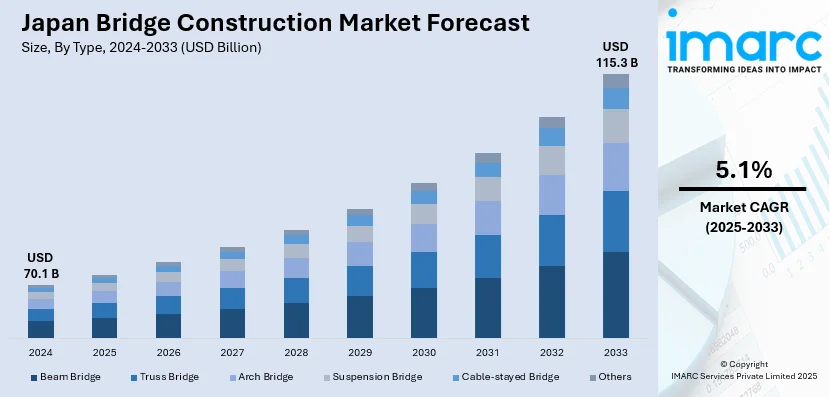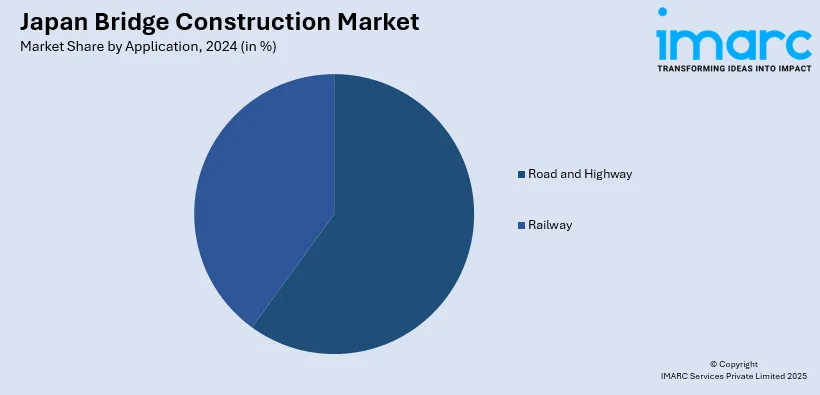
Japan Bridge Construction Market Size, Share, Trends and Forecast by Type, Material, Application, and Region, 2025-2033
Japan Bridge Construction Market Overview:
The Japan bridge construction market size reached USD 70.1 Billion in 2024. Looking forward, IMARC Group expects the market to reach USD 115.3 Billion by 2033, exhibiting a growth rate (CAGR) of 5.1% during 2025-2033. The market is driven by the adoption of advanced technologies, labor shortages, and demand for seismic-resistant designs. Sustainability initiatives, stricter regulations, and the use of high-performance materials such as CFRP and UHPC, alongside government investments in resilient and eco-friendly infrastructure, are further expanding the Japan bridge construction market share.
|
Report Attribute
|
Key Statistics
|
|---|---|
|
Base Year
|
2024 |
|
Forecast Years
|
2025-2033
|
|
Historical Years
|
2019-2024
|
| Market Size in 2024 | USD 70.1 Billion |
| Market Forecast in 2033 | USD 115.3 Billion |
| Market Growth Rate 2025-2033 | 5.1% |
Japan Bridge Construction Market Trends:
Increasing Adoption of Advanced Construction Technologies
The significant shift toward advanced construction technologies, driven by the need for efficiency and sustainability, is favoring the Japan bridge construction market growth. The government and private sector are increasingly adopting Building Information Modeling (BIM), drones, and AI-powered inspection systems to enhance project accuracy and reduce costs. BIM allows for precise 3D planning, minimizing errors during construction, while drones enable real-time monitoring of large-scale projects. Additionally, AI-based structural health monitoring systems are being deployed to assess bridge conditions, ensuring timely maintenance and extending lifespan. Another key trend is the use of prefabricated and modular construction methods to accelerate project timelines. With Japan’s aging workforce and labor shortages, off-site fabrication reduces on-site labor dependency and improves safety. These innovations align with Japan’s focus on resilient infrastructure, especially in earthquake-prone regions. As of 2023, Japan had a total workforce of 67.54 million individuals having an average age of 44.4 years. According to CPS, 40.1% of the workers aged 65-69 still are in the labor force, a sizeable fraction of labor-intensive industries, including construction. 29% of the national workforce is employed in the industrial sector, and the sector has become increasingly dependent on foreign labor, with 1.82 million foreign workers employed in the economy. But this sector is facing challenges, such as labor shortages and a drop in interest from younger generations. In infrastructure-heavy markets such as bridge construction, underperforming productivity affected, stressful working conditions, and excessive overtime driven by an excess of about 172 hours annually are other contributing factors. As a result, companies investing in smart construction technologies are gaining a competitive edge in the market.

Rising Demand for Seismic-Resistant and Sustainable Bridges
Japan’s bridge construction market is prioritizing seismic-resistant designs and sustainable materials due to increasing climate-related risks and stricter environmental regulations. Engineers are integrating high-performance materials such as carbon fiber-reinforced polymers (CFRP) and ultra-high-performance concrete (UHPC) to enhance durability against earthquakes and corrosion. These materials improve structural resilience and reduce long-term maintenance costs. Sustainability is also creating a positive Japan bridge construction market outlook, with a growing emphasis on eco-friendly construction practices. The government is promoting the use of recycled materials and low-carbon construction techniques to meet net-zero emissions targets. Additionally, green infrastructure projects, such as bridges with solar panels and rainwater harvesting systems, are gaining traction. The Japan construction industry is projected to reach USD 716.66 Billion by 2029. This expansion is largely driven by the creation of green infrastructure, improvements to seismic resilience, and the rehabilitation of aging bridge structures; 63% of road bridges are projected to be over 50 years old by 2033. The market is now investing in urban redevelopment, with an annual investment of over ¥70.3 Trillion (approximately USD 475 Billion), and major projects, including the Chuo Shinkansen and Osaka Expo. Additionally, numerous initiatives for smart cities, the establishment of green data centers, and the renovation of 8.49 million vacant homes underscore Japan's commitment to achieving carbon neutrality in its bridge and infrastructure improvements. As Japan continues to invest in disaster-resilient and environmentally friendly infrastructure, demand for innovative bridge solutions is expected to rise, shaping the future of the construction industry.
Japan Bridge Construction Market Segmentation:
IMARC Group provides an analysis of the key trends in each segment of the market, along with forecasts at the country level for 2025-2033. Our report has categorized the market based on type, material, and application.
Type Insights:
- Beam Bridge
- Truss Bridge
- Arch Bridge
- Suspension Bridge
- Cable-stayed Bridge
- Others
The report has provided a detailed breakup and analysis of the market based on the type. This includes beam bridge, truss bridge, arch bridge, suspension bridge, cable-stayed bridge, and others.
Material Insights:
- Steel
- Concrete
- Composite Materials
A detailed breakup and analysis of the market based on the material have also been provided in the report. This includes steel, concrete, and composite materials.
Application Insights:

- Road and Highway
- Railway
The report has provided a detailed breakup and analysis of the market based on the application. This includes road and highway and railway.
Regional Insights:
- Kanto Region
- Kansai/Kinki Region
- Central/Chubu Region
- Kyushu-Okinawa Region
- Tohoku Region
- Chugoku Region
- Hokkaido Region
- Shikoku Region
The report has also provided a comprehensive analysis of all the major regional markets, which include Kanto Region, Kansai/Kinki Region, Central/ Chubu Region, Kyushu-Okinawa Region, Tohoku Region, Chugoku Region, Hokkaido Region, and Shikoku Region.
Competitive Landscape:
The market research report has also provided a comprehensive analysis of the competitive landscape. Competitive analysis such as market structure, key player positioning, top winning strategies, competitive dashboard, and company evaluation quadrant has been covered in the report. Also, detailed profiles of all major companies have been provided.
Japan Bridge Construction Market News:
- April 05, 2025: Japan opened the world's longest pedestrian suspension bridge, measuring 420m long and 50m high, over a dam lake that is the longest one by 20 m than the Mishima Skywalk in Ibaraki, Osaka. This bridge can host as many as 800 visitors and opens up a better point to try bungee jumping at ¥16,000 (approximately USD 108.80), which is included in the "Dam Park Ibakita" for the entry fee of ¥550 (approximately USD 3.74). This marks a growing new commitment on the part of Japan to building recreational bridges as part of its broad efforts on infrastructure revitalization.
Japan Bridge Construction Market Report Coverage:
| Report Features | Details |
|---|---|
| Base Year of the Analysis | 2024 |
| Historical Period | 2019-2024 |
| Forecast Period | 2025-2033 |
| Units | Billion USD |
| Scope of the Report |
Exploration of Historical Trends and Market Outlook, Industry Catalysts and Challenges, Segment-Wise Historical and Future Market Assessment:
|
| Types Covered | Beam Bridge, Truss Bridge, Arch Bridge, Suspension Bridge, Cable-stayed Bridge, Others |
| Materials Covered | Steel, Concrete, Composite Materials |
| Applications Covered | Road and Highway, Railway |
| Regions Covered | Kanto Region, Kansai/Kinki Region, Central/Chubu Region, Kyushu-Okinawa Region, Tohoku Region, Chugoku Region, Hokkaido Region, Shikoku Region |
| Customization Scope | 10% Free Customization |
| Post-Sale Analyst Support | 10-12 Weeks |
| Delivery Format | PDF and Excel through Email (We can also provide the editable version of the report in PPT/Word format on special request) |
Key Questions Answered in This Report:
- How has the Japan bridge construction market performed so far and how will it perform in the coming years?
- What is the breakup of the Japan bridge construction market on the basis of type?
- What is the breakup of the Japan bridge construction market on the basis of material?
- What is the breakup of the Japan bridge construction market on the basis of application?
- What is the breakup of the Japan bridge construction market on the basis of region?
- What are the various stages in the value chain of the Japan bridge construction market?
- What are the key driving factors and challenges in the Japan bridge construction market?
- What is the structure of the Japan bridge construction market and who are the key players?
- What is the degree of competition in the Japan bridge construction market?
Key Benefits for Stakeholders:
- IMARC’s industry report offers a comprehensive quantitative analysis of various market segments, historical and current market trends, market forecasts, and dynamics of the Japan bridge construction market from 2019-2033.
- The research report provides the latest information on the market drivers, challenges, and opportunities in the Japan bridge construction market.
- Porter's five forces analysis assist stakeholders in assessing the impact of new entrants, competitive rivalry, supplier power, buyer power, and the threat of substitution. It helps stakeholders to analyze the level of competition within the Japan bridge construction industry and its attractiveness.
- Competitive landscape allows stakeholders to understand their competitive environment and provides an insight into the current positions of key players in the market.
Need more help?
- Speak to our experienced analysts for insights on the current market scenarios.
- Include additional segments and countries to customize the report as per your requirement.
- Gain an unparalleled competitive advantage in your domain by understanding how to utilize the report and positively impacting your operations and revenue.
- For further assistance, please connect with our analysts.
 Request Customization
Request Customization
 Speak to an Analyst
Speak to an Analyst
 Request Brochure
Request Brochure
 Inquire Before Buying
Inquire Before Buying




.webp)




.webp)












